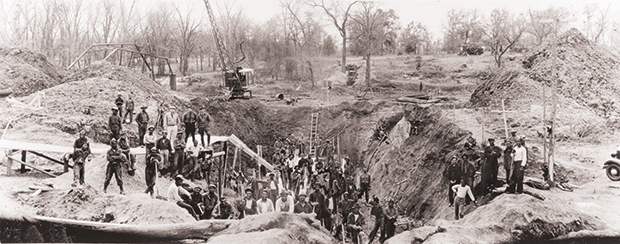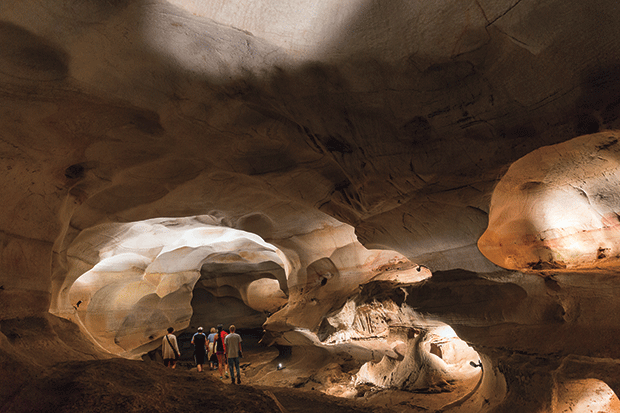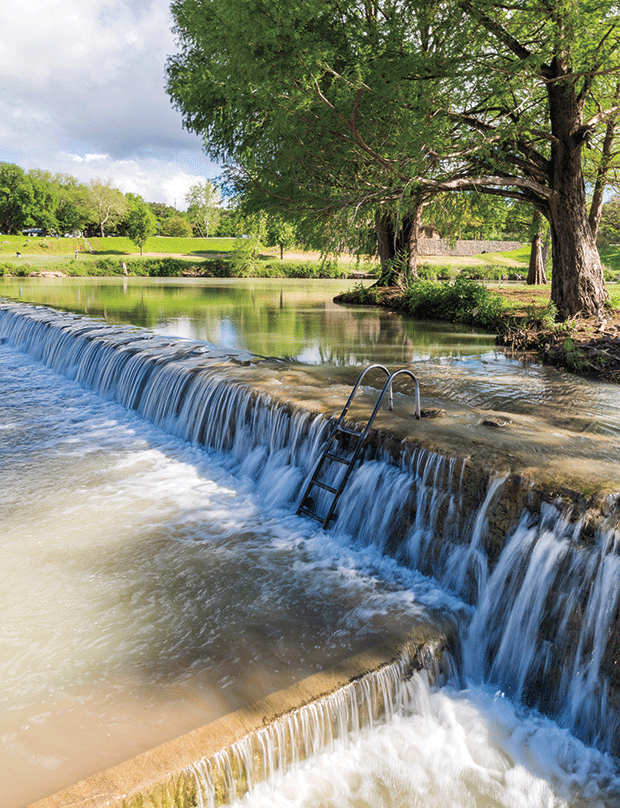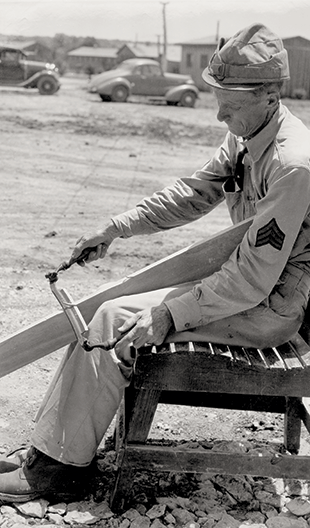
A picture window frames panoramic views from the stone overlook shelter at the top of Skyline Drive in Davis Mountains State Park. (Photo by Brandon Jakobeit)
When I was a child, Texas’ state parks were beloved vacation destinations. I became intimately familiar with the ubiquitous brown-and-yellow signs, the stoic stone buildings, rustic cabins, and cement picnic tables that dotted the state.
More on the CCC
(Photo courtesy Texas Parks and Wildlife)
For further reading on the CCC in Texas, look for Texas State Parks and the CCC: The Legacy of the Civilian Conservation Corps, by Cynthia Brandimarte with Angela Reed (Texas A&M University Press, 2013). The visually rich book covers the corps’ formation and building of the parks, along with stories of the CCC camps and ongoing management of the sites.Another excellent resource is Parks for Texas: Enduring Landscapes of the New Deal, by James Wright Steely (University of Texas Press, 1999), a comprehensive history of the creation of Texas’ state park system.
CCC in Texas
For an online interactive database and map of the 29 Civilian Conservation Corps state parks in Texas, go to www.texascccparks.org. For a complete list of Texas’ state parks, go to www.tpwd.texas.gov.
For an interactive database and maps of CCC projects nationwide, go to https://livingnewdeal.org.
They were all similar, yet unique to each site. The large limestone foundations of Central Texas gave way to adobe flair in the west, Spanish mission influence in the south, and piney log cabins in the east. I passed the plaques at the interpretive centers and didn’t give a second thought to the grainy black-and-white photos of men in rolled-up shirtsleeves posing on rock piles, or smiling from the roof of a dining hall, hammer in hand.
I became interested in these photos again as an adult. As a photojournalist and student of history, I like to comb through old images looking for moments and stories. The men who built the state parks of Texas were part of a program at a watershed in American politics and culture. Progressive politics, early environmentalism, and the biggest financial crisis the world had ever seen opened a window of opportunity for big ideas to take root.
During the Great Depression, as unemployment rose to a staggering 25 percent and a nine-year drought ushered in the Dust Bowl in the Midwest and Southern Plains, President Franklin D. Roosevelt proposed the Civilian Conservation Corps as a massive plan to put millions of young men to work in the conservation of America’s natural resources. From 1933 to 1942, the Civilian Conservation Corps left an enduring legacy on the Texas landscape and in the lives of more than 50,000 Texans. Dubbed “Roosevelt’s Tree Army,” the program gained wide bipartisan support, laid the foundation of our current parks system, and provided financial relief to millions of Americans.
At the start of the Great Depression, Texas seemed insulated from the wider financial stress of the stock market crash. Oil money and a diversified network of cotton, food crops, and wool kept the economy afloat until the early 1930s, when the prices of cotton and oil dropped and the drought worsened.

“Dam footing” at Fort Parker State Park, circa 1935. (Photo courtesy Texas Parks and Wildlife)
At the time, Texas had an anemic state parks system with 14 parks that together covered just over 800 acres. (By comparison, Texas state parks comprise more than 600,000 acres today.) The new state parks board struggled for land donations and legislative funding to develop and maintain the parks. Just weeks after Roosevelt announced the CCC, proposals flooded into Austin from communities all across Texas, each offering sites for new parks and asking for help with erosion, flood control, and farming practices.
Over the next nine years, CCC workers created 56 national, state, and local parks in Texas, growing the total acreage from 800 acres to 60,000 acres. Texas Parks and Wildlife still manages 29 of these state parks today.
All were crafted according to an architectural esthetic influenced by Frederick Law Olmsted, the designer of New York’s Central Park, and the Arts & Crafts movement that favored traditional craftsmanship and simple design over industrial production. Architects at the state and national level sought to minimize the silhouettes of buildings and use native materials to blend into the natural surroundings. The style came to be known as “National Park Service Rustic.” They built structures using pioneer methods of manual labor and rough-hewn materials. The resulting buildings, roads, and landscape improvements have stood the test of time.
Visitors to Texas state parks will immediately recognize the rustic style. The scenic lookout of Skyline Drive in Davis Mountains State Park rises from the cliff as a natural extension of local stone. Architects crafted the refectory of Goose Island State Park with a concrete mix of locally available sand and oyster shells. The reconstruction of 18th-Century Spanish Mission Nuestra Señora del Espíritu Santo de Zúñiga in Goliad State Park and Historic Site used quarried local stone and a kiln from the original settlement to fire thousands of floor tiles.

Among its many construction achievements, the CCC removed many tons of silt and guano from Longhorn Cavern, mapped the cave system and installed two miles of electric lights. (Photo © Julia Robinson)
The CCC was tasked with hiring young, often unemployed or otherwise idle young men. To hire as many as possible, the CCC remained an unskilled labor force, utilizing hand tools and the strength of numbers rather than complex machinery. Among its many construction achievements, the CCC removed many tons of silt and guano from Longhorn Cavern, mapped the cave system, and installed two miles of electric lights. Company 1856 built the world’s largest spring-fed pool at San Solomon Springs in Balmorhea, creating a travel destination for early automobile tourists in West Texas.
Some CCC workers learned refined skills from “Local Experienced Men,” or LEMs, who supervised more technical aspects of the construction. Electricians, engineers, architects, surveyors, plumbers, foremen, and artisans all contributed to the park sites. Specialized units for furniture and ironworks cropped up out of dedicated CCC camps in White Rock Lake, Bastrop, and Palo Duro Canyon.
Although the CCC’s work in state parks is best known to the public, many of the CCC camps in Texas provided help with soil conservation, erosion, and flood control, and worked with 5,000 farmers to update their agricultural practices. Private landowners would pay for materials and the CCC provided the labor.
Bill McDonald, who worked at soil conservation camp 3805 in Bartlett, recalled in a 2004 interview for a Texas Parks and Wildlife Department oral history project to commemorate the work of the CCC: “Right off, in very short order, I got my Ph.D.—Post Hole Digger!” CCC workers laid out miles of fencing, terraced farm fields, sodded grass, and built small earthen dams over the eastern and central parts of the state.
By the 1930s the timber industry had denuded many of East Texas’ natural pine forests. Retus Williams worked in Company 880 in an area that became Sabine National Forest. “We planted pine trees by the thousands,” he said in a 2003 interview with Texas Parks and Wildlife. “We did that for a long, long time.”
All told, the CCC planted 3 million trees on private and public lands in East Texas and developed four national forests with a total of more than 600,000 acres.
The CCC conserved the landscapes of Texas, but also conserved the human spirit of Texans. A high percentage of Texas CCC men came from families on relief—more than 80 percent— even after the relief requirement for enrollment was lifted in 1937.
Men ages 18 to 25 (later expanded to 17 to 28) enrolled in the program for six-month stints and up to two years of work. The average CCC enrollee had an eighth-grade education and had been unemployed for seven months before joining the Corps. The “CCC boys” earned $1 a day and were required to send $22-$25 home to their families or dependents each month. In this way, the CCC helped redistribute roughly $2 billion in wages nationwide.
Roosevelt forbade discrimination based on religious or racial grounds, but in practice many of the local agencies in charge of enlisting men in the program did just that. African Americans were never enrolled in the numbers that FDR envisioned, even though many were in more dire straits than their white counterparts.
Despite that, some CCC camps were integrated in the early years of the program, though the men had segregated mess halls, living quarters, and latrines. Starting in 1935 the camps became fully segregated with all-white, all-African American, and some all-Native American camps distributed around the nation. Other camps were made up of older World War I veterans.
In Texas, one of the first all-African American camps re-created Fort Parker, a historic replica of the place where Comanches captured Cynthia Ann Parker in 1836. The fort was part of the Texas Centennial celebration in 1936, and the men from Company 3807 rebuilt the stockades and a 423-foot dam across the Navasota River, creating Fort Parker Lake. The lake is now part of Fort Parker State Park, while the replica fort is a privately owned tourist attraction.
For M.F. Rutherford of Mexia, working at Fort Parker was a blessing. In a 2003 Texas Parks and Wildlife interview, Rutherford explained that after the Great Depression hit there was no farm work or paid employment to be found. By 1933, “we didn’t have anything, and finally wound up in a soup line.”

Blanco State Park’s stone buildings, dams and other structures were among the CCC’s earliest park projects in Texas. (Photo © Julia Robinson)
After joining the CCC in 1938, Rutherford was stationed eight miles from home at Fort Parker, where he worked in the rock quarry and as a truck driver. The workers built the fort on the ruins of Springfield, an African American freedmen’s colony from the mid-19th Century. After the park was completed, African Americans were, ironically, barred from entry, a relic of Jim Crow laws, until the 1960s.
“Now, mind you, now we’re talking about a time of segregation,” said Rutherford. “But yet, I didn’t have no problem with it because of what the President had did for me and my family. And not only for my family, but millions and millions of other families.”
Over his two years in the CCC, Rutherford sent his wages home to his parents, six siblings, and two cousins in Mexia. “You can just visualize how many people that paycheck reached and helped out,” he said.
Another success story, Dolores “Lolo” Baeza grew up on a family ranch just outside of Presidio on the Rio Grande and dreamed of traveling to far-off places when he joined the CCC in 1935. He was instead stationed in Big Bend working on park roads and later helped build Indian Lodge in the Davis Mountains.
His work on those sites began a two-decade career in carpentry. Later, he opened a chain of grocery stores in Fort Davis, Alpine, and Presidio. Lolo’s great granddaughter Berta Duarte works at Indian Lodge today and takes pride in her family’s legacy in the area.
Many Texans employed by the CCC went on to enlist in the armed forces during World War II. They credit their time in the CCC as preparation for their time in the military. “When I got that letter that says, Uncle Sam pointing at you, ‘We want you in the Army,’ I didn’t hesitate, because I was ready to go,” said Rutherford. Many of America’s Greatest Generation got their start in the CCC.
Collectively, the Texans of the CCC contributed more than 100 million hours of labor to conserving the landscape of Texas. Whether you smile cruising down a curving park road, or admire the arches of a visitor’s center or the towering quiet of a mature pine forest, you have to thank the Texans of the Civilian Conservation Corps for their herculean effort almost a century ago.









